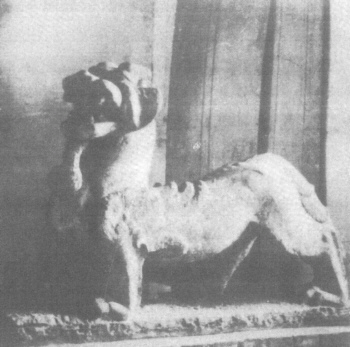Chapter 8 Section 2 Stone Que, Stone Beast
In Chinese history, there have been no purely commemorative architectural sculptures of Greek and Roman monumental columns and triumphal arches.Similar to it is the Han Stone Que (and the stone archway mentioned above), which is a work of art that integrates sculpture and architecture.There are about 40 Han stone palaces in existence, and about 20 are relatively intact, including Yangfu Junque in Mianyang City, Sichuan, Gaoyi Que in Ya'an City, Feng Huan Que in Qu County, Shenfu Jun Que, Fan Min Que in Lushan County, and Pan Palace in Chongqing City. Xiwuming Que, Dingfang Que in Zhongxian County, etc., the stone carvings, openwork carvings, relief carvings, or line carvings are all very exquisite.Stone ques are mainly tomb ques (and a small number are temple ques, such as Taishi, Shaoshi and Qimu three ques in Songshan, Henan), which are highly comprehensive sculptures.In addition to showing that it is the entrance to the kingdom of heaven, it has other functions.The name and identity of the owner of the tomb are often engraved on the que, which is representative; on the body of the que, there are relief sculptures such as the Queen Mother of the West, gods, legends, traveling by car, etc. It is also a concentrated and sacrificial ancestral hall.These inscriptions, reliefs and the connotations derived therefrom make the stone tower like an introduction or preface to the tomb area. Before people enter the tomb area, the stone tower gives people a rough and general understanding.The stone tower is built like a wooden tower. In this sense, the stone tower itself is a large stone sculpture.The stone que is gorgeous because of the reliefs of different heights all over the que body, and because of its shape, the eaves of the que roof imitating the roof are larger. Compared with the upright que body, it is like the wings of a bird and has a kind of rising feeling.From the viewer's psychological point of view, the stone tower is the first climax of the mausoleum sculpture.
Stone beasts are representative of large round sculptures.According to the type of art, stone beasts mainly include Han stone beasts, Southern Dynasty stone beasts, and Tang Ling stone beasts.Han stone beasts are generally not very large in size and have a strong sense of movement.Those stone lions striding and twisting, or Tianlu and warding off evil spirits with their heads raised and roaring, in expressing dynamics, they also have the flexibility that is often seen in the depiction of animals in the Han Dynasty.Like the bronze plain wares of the Han Dynasty, the stone beasts of the Han Dynasty paid more attention to the modeling effect similar to the shape of the animal itself.Regardless of their size, the stone beasts of the Han Dynasty always make people feel that they are living flesh and blood. (Figure 8) The famous stone beasts in the Southern Dynasties are the stone unicorns and other mythical beasts in the royal tombs of the Six Dynasties in Nanjing.These stone beasts are huge in size, and due to the extensive use of highly decorative relief lines to represent the feathers and wings of the hyena (lie hunting), these huge and heavy stones also become elegant and flowing.These artistic treatments are extremely harmonious with the overall atmosphere of the mausoleum and the spirit of the stone beast itself, and are also consistent with the magnificent cultural characteristics of the entire Southern Dynasty.The stone beasts of the Tang Mausoleum are larger than the stone beasts of the Han Dynasty and slightly different from the stone beasts of the Six Dynasties. Judging from the characteristics of the sculpture, they are the most commemorative.The reason is first of all that these stone beasts have a strong sense of architecture and dignity, without too many detailed descriptions and excessive dynamics.The second is the weakening of the spiritual energy and the strengthening of the spiritual effect.These stone beasts obey the overall conception of the entire mausoleum sculpture, and are created for the purpose of showing meritorious service and proclaiming prestige.For example, the stone lion of Qianling Mausoleum, with its majestic posture that disdains everything, cannot accommodate a second sculpture in a rather large space.This ability to occupy a vast space comes from the architectural sense and rich spiritual connotation of stone lions.Among the stone beasts in the mausoleums of the past dynasties, the stone carvings of Huo Qubing's tomb in the middle of the Western Han Dynasty are very unique.The stone carvings of Huo Tomb are chiseled out of huge stones. During the chiseling process, the natural shape of the original stone was used as the basis for creation, and it was chiseled after ingenious conception.For example, a fish was originally a giant stone with slightly smaller ends and a thicker middle. The eyes and mouth of the fish were carved at the small end, and the other parts were slightly processed, and a stone sculpture of a giant fish was produced.Another example is the crouching tiger, which makes good use of the undulations of the stone surface and the direction of the stone grains. The carved tiger makes people feel the luster of fur and the softness of the body.The stone carvings of Huo Tomb are very in line with Lao Zhuang's artistic ideas of "combining the sky with the sky" and "both carving and carving, returning to simplicity". It is a successful example of using natural materials.

Figure 8. Stone Beast Unearthed in Xianyang, Shaanxi, Eastern Han Dynasty

Figure 8. Stone Beast Unearthed in Xianyang, Shaanxi, Eastern Han Dynasty
